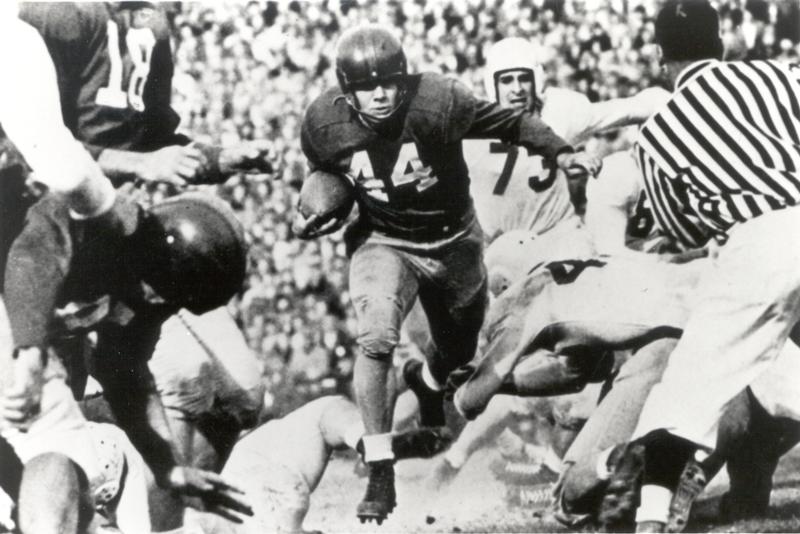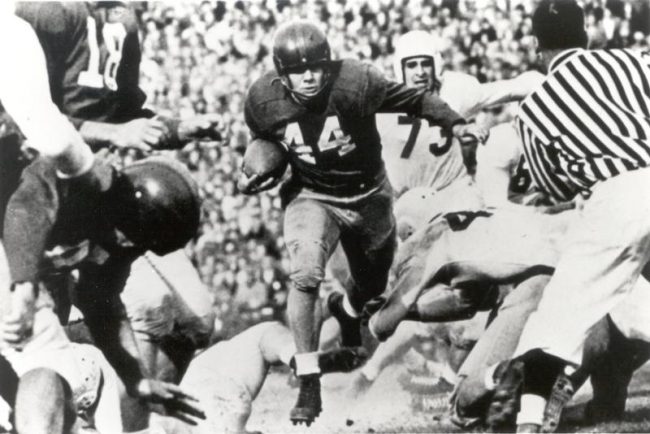
SMU, Giants star dies
Kyle Rote was an All-American halfback at SMU (1950) and a receiver with the New York Giants (1951-61).
Kyle Rote Sr., a former SMU All-American in 1950 and NFL New York Giants star, died Wednesday night. He was 73.
Rote died of complications from pneumonia in a Baltimore Hospital, where he was admitted Aug. 4 for emergency hernia surgery.
Rote was a long-time smoker who also battled emphysema in recent years.
At SMU Rote played alongside 1948 Heisman trophy winner Doak Walker. The next year Rote led the Southwest Conference with 777 yards rushing.
Rote gained national fame in 1949 at SMU in a college game against national champion Notre Dame. He rushed for 115 yards, completed 10 passes for 146 yards and scored all the Mustangs’ points in a 27-20 loss.
In 1950, Rote came in second with 280 votes in the SMU Heisman Trophy voting.
He was the No. 1 pick in the 1951 NFL draft and had a record-setting career as a wide receiver for the New York Giants. Rote finished his first NFL season with 9-2-1.
Rote started out as a running back his first year in the NFL until he stepped in a hole and tore his ACL in Jonesboro, Ark. After recuperating, he returned to the NFL as a wide receiver.
He played 11 seasons and made the All-Pro team four times.
He was also the first elected president of the NFL Players Association. 1961 was Rote’s last year in the NFL due to a career-ending knee injury.
While on the Giants, Rote caught 300 passes for 4,797 yards, maintained a 16-yard average and had 48 touchdowns. He was the team’s all-time leading receiver when he retired. He is currently fifth among Giants. His 312 points are 10th best in Giants history.
Following his playing career, Rote coached the Giant’s offensive backfield for two seasons and saw the Giants win the Eastern Division championships. He later turned to broadcasting and was one of NBC’s top sportscasters in the late 1960s and 1970s.
Rote’s son, Kyle Rote Jr., now a sports agent, was an all-state football player in Dallas. Instead of pursuing football like his father, he actually went on to become a No. 1 draft pick in the North American Soccer League (NASL) in 1973 and was named Rookie of the Year.
Former Giants’ reactions to Kyle Rote’s death:
“He was so good at everything, whether it was Ping-Pong, pool or kicking off,” Mara Wellington said. “The outstanding backs of that era were Alex Webster and Frank Gifford. Before Kyle hurt his knee, he was as powerful a runner as Webster was and as smooth a runner and as good a receiver as Gifford was. He just had so much ability.”
“He went to wide receiver and had an incredible career, considering he did it on one leg,” Frank Gifford said.
“Kyle was a big part of what made the Giants successful,” Sam Huff said. “He set the standard for excellence. He was the offensive captain of the Giants, and he deserved it. You can’t say enough about him. He was a gutsy ballplayer.”
Information compiled from online sources.









